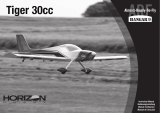
11
•BEFORE STARTING ASSEMBLY
• Remove parts from bag.
• Inspect fuselage, wing panels, rudder and stabilizer for
damage.
• If you fi nd damaged or missing parts, contact your place
of purchase.
If you fi nd any wrinkles in the covering, use a heat gun
(HAN100) and covering glove (HAN150) or covering iron
(HAN101) with a sealing iron sock (HAN141) to remove them.
Use caution while working around areas where the colors
overlap to prevent separating the colors.
• Charge transmitter and receiver batteries.
• Center trims and sticks on your transmitter.
• For a computer radio, create a model memory for this
particular model.
• Bind your transmitter and receiver, using your radio
system’s instructions.
IMPORTANT: Rebind the radio system once all control
throws are set. This will keep the servos from moving to their
endpoints until the transmitter and receiver connect. It will
also guarantee the servo reversal settings are saved in the
radio system.
•VOR DEM ZUSAMMENBAU
• Entnehmen Sie zur Überprüfung jedes Teil der Verpackung.
• Überprüfen Sie den Rumpf, Tragfl ächen, Seiten- und
Höhenruder auf Beschädigung.
• Sollten Sie beschädigte oder fehlende Teile feststellen,
kontaktieren Sie bitte den Verkäufer.
Zum Entfernen von Falten in der Bespannung verwenden
Sie den Heißluftfön (HAN100) und Bespannhandschuh
(HAN150) oder das Folienbügeleisen (HAN141). Bitte achten
Sie bei überlappenden Farben, dass Sie diese sich bei dem
Bearbeitung nicht trennen.
• Laden des Senders und Empfängers.
• Zentrieren der Trimmungen und Sticks auf dem Sender.
• Sollten Sie einen Computersender verwenden, resetten Sie
einen Speicherplatz und benennen ihn nach dem Modell.
• Sender und Empfänger jetzt nach den Bindeanweisung
des Herstellers zu binden.
WICHTIG: Wir empfehlen dringend nachdem alle
Einstellungen vorgenommen worden sind, das Modell
neu zu binden. Dieses verhindert, dass die Servos in die
Endanschläge laufen bevor sich Sender und Empfänger
verbunden haben. Es garantiert auch, dass die
Servoreverseeinstellungen in der RC Anlage gesichert sind.
•AVANT DE COMMENCER L’ASSEMBLAGE
• Retirez toutes les pièces des sachets pour les inspecter.
• Inspectez soigneusement le fuselage, les ailes et les
empennages.
• Si un élément est endommagé , contactez votre revendeur.
Si l’entoilage présente quelques plis, vous pouvez les lisser
en utilisant le pistolet à air chaud (HAN100) et le gant
(HAN150) ou le fer à entoiler (HAN101) avec la chaussette
de protection (HAN141). Agissez soigneusement dans les
zone ou plusieurs couleurs d’entoilage sont superposées afi n
d’éviter de les séparer.
• ll est recommandé de préparer tous les éléments du
système de la radio.
• Cela inclus, la charge des batteries comme la mise au
neutre des trims est des manches de votre émetteur.
• Si vous utilisez une radio programmable, sélectionnez une
mémoire libre afi n d’y enregistrer les paramètres de ce
modèle.
• Nous vous recommandons d’affecter maintenant le
récepteur à l’émetteur en suivant les instructions fournies
avec votre radio.
IMPORTANT: Il est hautement recommandé de
ré-affecter le système une fois que les courses seront
réglées. Cela empêchera les servos d’aller en butée lors de
la connexion du système. Cela garantit également que la
direction des servos est enregistrée dans l’émetteur.
•PRIMA DI INIZIARE IL MONTAGGIO
• Togliere tutti i pezzi dalla scatola.
• Verifi care che la fusoliera, l’ala e i piani di coda non siano
danneggiati.
• Se si trovano parti danneggiate, contattare il negozio da
cui è stato acquistato.
Se si trovano delle rughe nella ricopertura, si possono
togliere usando una pistola ad aria calda (HAN100) e guanto
per ricopertura (HAN150), oppure un ferro per ricopertura
(HAN101) con la sua calza di protezione (HAN141). Usare
cautela quando si lavora in aree del rivestimento dove ci
sono dei colori sovrapposti, per evitare la loro separazione.
• Caricare il trasmettitore e la batteria di volo.
• Centrare stick e trim sul trasmettitore.
• Con una radio computerizzata creare una nuova memoria
per questo modello.
• Facendo riferimento alle istruzioni del radiocomando,
connettere (bind) trasmettitore e ricevitore.
IMPORTANTE: Ripetere la procedura di connessione
una volta regolate le corse, per evitare che i servi vadano a
fi ne corsa. Garantirà anche che le impostazioni di inversione
del servo vengano salvate nel sistema radio.


























